Westley:
Why can't I move? Why am I up against this wall?
Fezzik:
You've been mostly-dead all day.
-The Princess Bride
In some unfortunate folks, the "arch" of the aorta becomes
diseased. The layers of the aorta split apart; a separation which
spreads under the pounding of blood ejected from the heart. Over time
(sometimes quickly) it can result in stroke, catastrophic heart attack,
or sudden bleeding into the chest as the split advances to the
branching arteries leaving the aorta for their target organs. This is
called an aortic arch dissection. Alternately, the aorta can weaken,
bulging like the bubble of an inner tube into an aneurysm which, if it
ruptures, is almost always rapidly fatal.
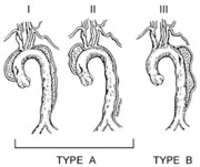 If the proximal arch, the segment between the heart and the blood
vessels branching off to the head and
brain, is involved (type 1
dissection), the treatment is urgent surgery to replace that section.
If the dissection involves the aortic valve at the proximal end (close
to the heart) the valve is usually replaced as well. At the distal end
(away from the heart) branching blood vessels perfusing (feeding) the
heart, brain and head are sometimes involved; these then, have to be
disconnected, and anastamosed (connected) to the woven dacron or gortex
artificial tube which is used to replace the sick aorta. In order to do
this, the circulation must be stopped; no blood flow at all...
If the proximal arch, the segment between the heart and the blood
vessels branching off to the head and
brain, is involved (type 1
dissection), the treatment is urgent surgery to replace that section.
If the dissection involves the aortic valve at the proximal end (close
to the heart) the valve is usually replaced as well. At the distal end
(away from the heart) branching blood vessels perfusing (feeding) the
heart, brain and head are sometimes involved; these then, have to be
disconnected, and anastamosed (connected) to the woven dacron or gortex
artificial tube which is used to replace the sick aorta. In order to do
this, the circulation must be stopped; no blood flow at all...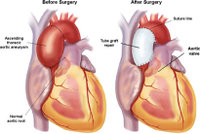
Anesthesia is induced, lines and monitors are placed (ET tube, a-line, PA
catheter, transesophageal echo, brain function, brain oxygen, multiple temp, pulse ox, foley, ECG, big IVs) and the chest is opened. The patient is totally
anticoagulated. The surgeon places cannulae (tubes) in the great veins
of the chest (superior and inferior vena cavae) and in the groin
artery, the femoral. The heart is stopped and preserved by flooding
it with ice cold potassium bearing solution (cardioplegia), and the
body is cooled. Usually the cooling is continued until the patient is
below 70 degrees fahrenheit-room temperature. measured at the back of
the nose (as close as we can get to the brain). During this time, the
heart-lung 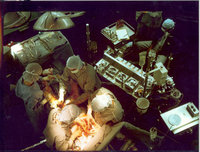 machine ("the pump") is driving cold blood around the
arterial system through that tube in the groin
artery. Blood is
collected from the tubes in the great veins, cooled and oxygenated
respectively in the heater/cooler and membrane oxygenator, and back in
it goes. And then, the pump is turned off, and all blood flow is stopped...
machine ("the pump") is driving cold blood around the
arterial system through that tube in the groin
artery. Blood is
collected from the tubes in the great veins, cooled and oxygenated
respectively in the heater/cooler and membrane oxygenator, and back in
it goes. And then, the pump is turned off, and all blood flow is stopped...
At 70 degrees, the patient is cold to the touch; the first time you
feel a 70 degree cheek, you shudder. The patient looks ghostly above
the ether screen; they look...cadaverous. Which technically, I suppose, they are, sort of. When the pump is stopped, the
room gets quiet. A timer is started. There is no music. There is no
idle chatter. If somebody walks into the room talking, they are shushed. The
surgeons talk in low voices as they sew. Circ arrest cases are
intimate, somehow; it's sacred ritual. I believe in cold, so I surround the head with ice
bags wrapped in towels during arrest. I doubt it helps the patient much extra, but
it helps me.
From the moment the pump is stopped, the patient begins to decay.
No heart or lung function. No brain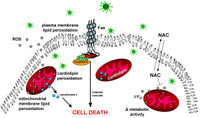 activity. Like freshly caught
fish, the body starts to rot. Decomposition, a process of fat
oxidation (free radical breakdown of lipids) is greatly slowed by cold.
Fish at room temperature; a few hours. Fish at 34 degrees; a couple of
days. When fish smells fishy, it is the odor of the omega-fish fats
being oxidized. In
humans who we expect to re-animate, the situation is
the same. At 68 degrees, energy requiring cellular processes
are essentially abolished. Patients are in a state of suspended
animation. It's like we've dropped them out of the plane at altitude,
and we are swooping down with a net to catch them in their slow motion
free-fall before
they hit the ground. Patients can last this way about an hour,
sometimes a little
activity. Like freshly caught
fish, the body starts to rot. Decomposition, a process of fat
oxidation (free radical breakdown of lipids) is greatly slowed by cold.
Fish at room temperature; a few hours. Fish at 34 degrees; a couple of
days. When fish smells fishy, it is the odor of the omega-fish fats
being oxidized. In
humans who we expect to re-animate, the situation is
the same. At 68 degrees, energy requiring cellular processes
are essentially abolished. Patients are in a state of suspended
animation. It's like we've dropped them out of the plane at altitude,
and we are swooping down with a net to catch them in their slow motion
free-fall before
they hit the ground. Patients can last this way about an hour,
sometimes a little  longer, before enough lipid is degraded to begin to
destroy cellular integrity. As time passes, the likelihood of stroke
increases. Two hours is way too long.
longer, before enough lipid is degraded to begin to
destroy cellular integrity. As time passes, the likelihood of stroke
increases. Two hours is way too long.
Once the repair is effected, the pump is restarted and flow is re-established. Then begins a long period of rewarming, maybe an hour and a half or so, culminating in separation from bypass, which can sometimes be a challenge; the cold and handling "stun" even healthy heart muscle, which consequently doesn't beat very vigorously for some time after. During re-warming, there's relatively less to do; the surgeons tidy up their repair. I prepare various drug drips and tend to the anesthetic. The mood in the room lightens; music is turned on, we chat while we watch the temp rise in the bladder, nose, and blood.
There is some promising data looking at even colder temperatures; this is limited by much longer rewarming time, and thus, extended pump time; very long pump runs are themselves injurious, causing lung, heart and kidney injury through inflammatory activation. Interestingly, most of the injury seems to occur after circulation is restored and the patient is rewarmed. Then, affected cells commit suicide-apoptosis. This is called re-perfusion injury. Out of all the organs, the brain is most sensitive. One hour or so. Kidneys next, and gut. Other things later. Hair follicles survive a long time-days.
Circ arrest cases are very demanding; there's no room for error; there are no "do-overs."
Anesthetic technique for circ arrest is like making fresh mayonnaise;
simple ingredients, impeccable technique. In this case, the ingredients
are physiologic; maintenance of good physiology during cooling,
rewarming, and separation from bypass. Fancy ingredients (barbiturates,
lidocaine, etc) don't seem to add much to sustainable circ arrest time
or odds of functional survival.
My longest circ arrest time is 79 minutes. The patient, a 47 year old father of three young kids, did great; out of the unit in three days. He showed me pictures of his kids at his bedside. Two of them had drawn pictures for their daddy. In cases like this, I make it a point to do repeated post-op rounds; it gives me strength for the journey...
 Mitch Keamy is an anesthesiologist in Las Vegas Nevada
Mitch Keamy is an anesthesiologist in Las Vegas Nevada
 Andy Kofke is a Professor of Neuro-anesthesiology and Critical Care at the University of Pennslvania
Andy Kofke is a Professor of Neuro-anesthesiology and Critical Care at the University of Pennslvania
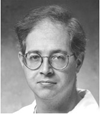 Mike O'Connor is Professor of Anesthesiology and Critical Care at the University of Chicago
Mike O'Connor is Professor of Anesthesiology and Critical Care at the University of Chicago
 Rob Dean is a cardiac anesthesiologist in Grand Rapids Michigan, with extensive experience in O.R. administration.
Rob Dean is a cardiac anesthesiologist in Grand Rapids Michigan, with extensive experience in O.R. administration.
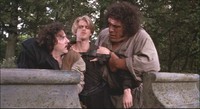
Mitch,
Thanks for sharing. As a double valve replacement patient, I'm always interested in anything related to the heart.
Adam
http://www.heart-valve-surgery.com
Posted by: Adam Pick | September 14, 2024 at 04:10 PM
First case of circulatory arrest with deep hypothermia I saw was an infant with anomolous pulmonary venous return. Cold and static, ice packed around the heart: by pretty much any criteria, the child was dead during the operation; and, other than having a few tubes here and there, seemed ready for discharge the next day.
A very nicely written -- poetic, really -- treatise. Thanks.
Posted by: Sid Schwab | September 14, 2024 at 09:34 PM
beautiful
Posted by: Bongi | September 15, 2024 at 03:22 PM
Very intriguing. Cardiac is the one specialty I have never had the privelege to scrub or assist in. Very descriptive. Tell us more?
MMT
Posted by: makeminetrauma | September 15, 2024 at 06:43 PM
Great descriptive post, Mitch. The very first time I've ever heard of this procedure was through the Gray's Anatomy series lol. I kinda shuddered involuntarily when you described that the patient begins to decay. Ew...
Posted by: Jason | September 15, 2024 at 07:54 PM
You've been tagged. http://rlbatesmd.blogspot.com/
Posted by: rlbates | September 24, 2024 at 06:05 AM
Mitch,
You my friend are a very special individual. Your passion for what you do is immediately discerned in your eloquent writing. Anyone who you work on is blessed to be in your hands. As an aortic surgery suvivor, my surgeon was like you. It would be great if all doctors in all fields had a passion like you. You are gifted. Keep up the good work.
Benjamin J. Carey
http://www.heartosaurus.com
Posted by: Benjamin J. Carey | November 12, 2023 at 12:48 PM